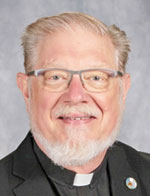That All May Be One / Fr. Rick Ginther
A primer on our Jewish brethren and their High Holy Days of faith
 (The following is an article written by Dr. Alan Bercovitz, who is Jewish. He is married to Janine, who is Catholic and a member of St. Thomas Aquinas Parish in Indianapolis. Together, they regularly attend a Jewish Saturday service and Sunday Mass. My thanks to Alan for allowing the use of his clear, descriptive summary. Far better for one who lives and prays these High Holy Days to write than one who only knows them through books!)
(The following is an article written by Dr. Alan Bercovitz, who is Jewish. He is married to Janine, who is Catholic and a member of St. Thomas Aquinas Parish in Indianapolis. Together, they regularly attend a Jewish Saturday service and Sunday Mass. My thanks to Alan for allowing the use of his clear, descriptive summary. Far better for one who lives and prays these High Holy Days to write than one who only knows them through books!)
The Jewish faith just celebrated the 10-day period known as Yamin Noraim, the Days of Awe, more commonly known as the High Holy Days, which include Rosh Hashanah and Yom Kippur.
For centuries, Jewish people have gathered as a community to stop and think about the year past and the year ahead. This time is called Rosh Hashanah.
This year, Rosh Hashanah began at sundown on Sept. 15, which corresponded to the first day of Tishrei in the year 5784 on the Hebrew calendar. It ended at sundown on Sept. 17.
Rosh Hashanah, “The Head of the Year,” is a gift of time and an opportunity to learn and grow. It is a happy time as we welcome the New Year, but it is also a serious time as we think about ourselves, what we have done in the past year, and how we may do better in the year ahead.
We eat apples dipped in honey in the hope of a sweet New Year. In a dramatic and powerful part of the service, the Shofar, or ram’s horn, is blown to announce the New Year and awaken in us the intention to do better. We ask God for a happy and peaceful year, and we give thanks to God for all good things.
God opens the Book of Life, which contains all the things we have done in the past year. Each of our lives comes before God, and God judges us for the coming year. The Book is kept open, and we each have the power to change our judgment through prayer, forgiveness and good deeds. (The Book is closed at the end of Yom Kippur.)
When the service concludes, we say “L’Shanah Tovah Tikatevu,” may you be written in the Book of Life for a good year.
Yom Kippur began at sundown on Sept. 24 (the 10th of Tishrei) and ended at sundown on Sept. 25.
Yom Kippur, “The Day of Atonement,” is the holiest day of the Jewish year. It is serious and holy, but not sad.
After a festive meal, a fast is begun prior to the start of services. This fast allows more time to pray and helps us to know hunger.
Kol Nidre, “all the vows,” the most beautiful service of the year, begins at sundown. We ask God for forgiveness. It is the only evening service when tallit (prayer shawls) are worn. The Torah are taken out, and the Kol Nidre prayer is chanted three times.
An all-day service follows the next day, as we pray a confession of sins, not only for our own sins, but for the sins of others, for things either done or not done.
Yizkor, a memorial service, is the time to remember family and friends who have died. To honor their memory, we promise to give Tzedakah, or contributions, to help those in need. The biblical story of Jonah is told during the service.
Neilah, or “closing,” is the final part of the service, as the Book of Life is closed. The Shema is chanted to reaffirm our belief in God, and the Shofar is once again blown. After sundown, the long fast is broken.
As each of us look at our individual lives during this period of introspection, may we all as well look at the vast world around us that continues to need our prayers.
(Father Rick Ginther is director of the archdiocesan Office of Ecumenism and Interreligious Affairs. He is also the pastor of Our Lady of Lourdes Parish in Indianapolis.) †
 (The following is an article written by Dr. Alan Bercovitz, who is Jewish. He is married to Janine, who is Catholic and a member of St. Thomas Aquinas Parish in Indianapolis. Together, they regularly attend a Jewish Saturday service and Sunday Mass. My thanks to Alan for allowing the use of his clear, descriptive summary. Far better for one who lives and prays these High Holy Days to write than one who only knows them through books!)
(The following is an article written by Dr. Alan Bercovitz, who is Jewish. He is married to Janine, who is Catholic and a member of St. Thomas Aquinas Parish in Indianapolis. Together, they regularly attend a Jewish Saturday service and Sunday Mass. My thanks to Alan for allowing the use of his clear, descriptive summary. Far better for one who lives and prays these High Holy Days to write than one who only knows them through books!)